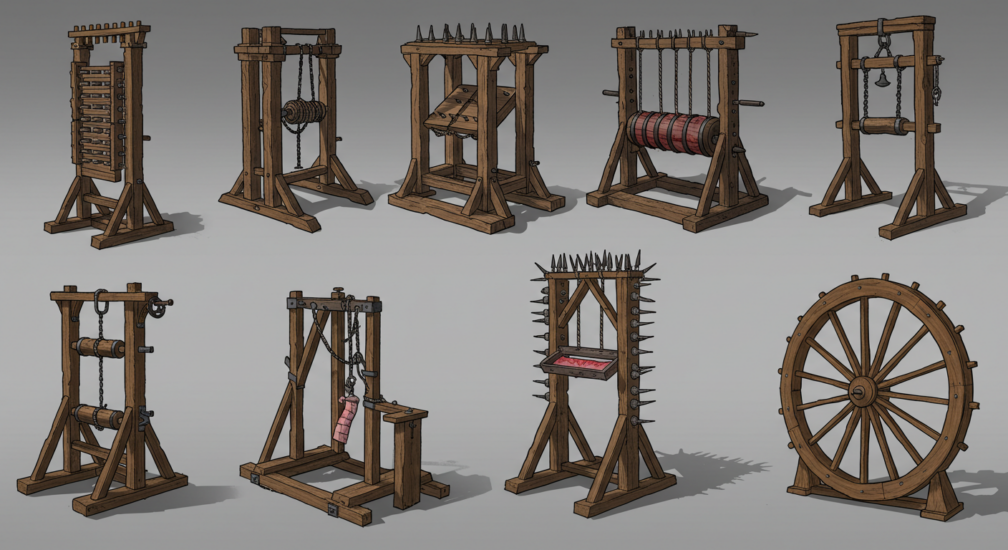Throughout history, few subjects evoke more horror, fascination, and reflection than medieval torture devices. These relics of brutality-created with unsettling ingenuity-once symbolized the darker corners of human oppression. By examining how torture devices worked, we gain insight into the balance of justice and cruelty that governed the Middle Ages. From punishing heretics to extracting confessions, these instruments fueled the flames of fear, ensuring obedience through pain.
The Roots of Horror and Oppression
In a society shaped by the Inquisition and power struggles, medieval torture practices thrived as a twisted method of deterrence. In an age with limited investigative procedures, extracting admissions of guilt often relied on direct suffering or psychological torment. But how did medieval torture work in practical terms? Skilled artisans forged iron, wood, and rope into contraptions designed to force confessions under extreme agony. The church and state wielded such instruments to maintain order, projecting barbarity masked as a duty of governance.
Yet, understanding these methods reveals more than just human savagery. Each piece in the list of medieval torture devices tells a story of clever engineering, from pivots and levers that ensured slow, methodical pain, to hinged frames that contorted bodies for maximum torment. Ironically, these devices stand as feats of mechanical design-even if their purpose was horrifying.
Types of Torture Devices: Mechanisms of Suffering
A thorough look at the types of torture devices reveals the variety of methods used to instill lasting dread. Some contraptions wielded heavy blunt force, while others inflicted precise injuries or public humiliation. Below is a condensed overview of key instruments:
- Rack
Perhaps the most iconic among the most brutal torture devices, the Rack employed rollers and ropes to gradually stretch a prisoner’s limbs. Adjusting tension with a crank gave tormentors control over each wrenching moment of suffering. - Iron Maiden
A spiked chamber intended to pierce captives from all angles. Although its historical authenticity is debated, the Iron Maiden endures as a chilling symbol of punishment and fear. - Scavenger’s Daughter
This apparatus compressed rather than stretched. Built from hinged iron, it slowly forced a prisoner’s body into a compressed position, crushing the spine and chest. - Catherine Wheel
A large wooden wheel used for execution or mutilation, its design harnessed the wheel’s broad surface to maximize impact. Publicly displayed, it amplified the era’s emphasis on deterrence through horror.
Each item demonstrates not just cruelty but also mechanical ingenuity. By studying the mechanism behind each, we recognize how instruments once revered for their efficacy in punishment now serve as cautionary relics of a violent past.
Witnessing the Legacy: Museums and Exhibits
Modern exhibits offer a safe way to explore these ancient torture methods, shedding light on how they were deployed. Visitors who want to experience the stark reality of these relics can visit the Medieval Torture Museum in Chicago. Within its walls, you’ll find detailed replicas, period documents, and educational materials unveiling the logic behind each invention’s design.
For those traveling to California, the Medieval Torture Museum in LA expands on this narrative, situating various devices within broader historical contexts, from witch trials to political conflicts. Each display illustrates how torture devices worked on a practical level, but also raises ethical discussions about the justification used to legitimize such brutality.
Meanwhile, if you’re on the hunt for st augustine things to do, the Medieval Torture Museum in St Augustine provides another immersive angle. Visitors explore relics that once symbolized oppression, stepping into a world of gloom that highlights how medieval leaders balanced fear and control through public torment.
Why Study Medieval Torture Devices?
Confronting these devices can spark deep reflection on human nature, power structures, and the concept of justice. Each object encapsulates an era’s mindset: a willingness to harness barbarity for social compliance. By learning about the methods used to coerce or punish, we better grasp how institutions justified employing such extreme tactics.
- Moral Lessons
Observing the physical remnants of execution and prolonged agony fosters empathy. It reminds us that laws, once accepted without question, can cross the line into cruelty. - Historical Insight
Understanding medieval torture devices deepens our knowledge of Middle Ages governance, showing how societies used systematic terror to regulate behavior. - Engineering Marvels
Despite the gruesome ends these devices served, they reflect technical savvy. Levers, gears, and load-bearing frames demonstrate advanced craftsmanship, albeit for immoral ends. - Cultural Continuum
These instruments contributed to evolving definitions of rights and humane treatment. Over centuries, moral revolutions have pushed beyond the horrors once normalized.
A Shift from Pain to Introspection
Today, these contraptions stand as reminders of a darker legacy, stirring questions about how civilization must guard against lapses into moral depravity. By revisiting these methods-whether through a museum visit or historical texts-we honor victims by understanding their trials and ensuring that similar atrocities never recur.
For more gripping details, you can delve into our official blog. There, expert articles and updated research dissect the origins of each device, the role of fear in societal control, and the slow, often painful process through which humanity has moved toward more humane concepts of punishment.
A Testament to Both Ingenuity and Cruelty
In the end, these relics of the medieval era illustrate two polar facets of humanity: our capacity for complex invention and our equally potent ability for oppression. Each entry on the list of medieval torture devices offers a window into an age shaped by punishment, horror, and fear. Paradoxically, the same craftsmanship that forged cathedrals and castles also built contraptions designed for suffering.
Exploring how these machines functioned reveals the stark reality behind the Middle Ages’ approach to justice. It’s a call to remember that societies, regardless of era or region, can be swayed into legitimizing cruelty if left unchecked. By witnessing these most brutal torture devices in educational exhibits, we transform horror into insight, ensuring we learn from our ancestors’ mistakes rather than replicate them.
A deeper understanding of these medieval torture practices heightens our appreciation for the progress modern civilization has achieved-and underscores the importance of continuing that journey toward fairness, empathy, and compassion.






